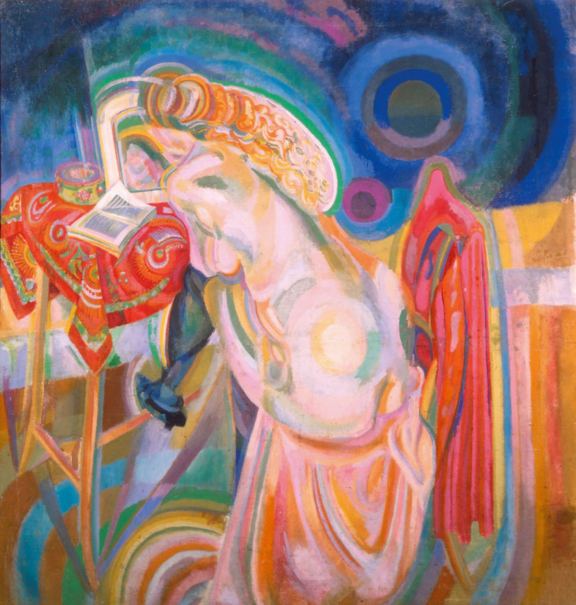
- 1915
- Canvas
- Oil and Tempera
- Inv. PE113
Robert Delaunay
Femme Nue Lisant
Femme Nue Lisant (Nude Woman Reading) belongs to a group of works on this theme by Robert Delaunay during the years he lived on the Iberian Peninsula, between 1914 and 1921. It is, in the words of the artist, the application to the human figure of his previous artistic discoveries: «transparent, iridescent, almost a rainbow, but robust and firm in its realist construction. Anti-descriptive, this nude reflects the entire [chromatic] spectrum of the country, beyond its pale flesh colouring.»* During his residence in Madrid, in the first semester of 1915, Robert had been particularly interested by Rubens’ use of colour, highlighting, among the various paintings in the Prado collection, the canvas Diana and Calisto (1638-40), of which he had a reproduction and which directly influenced him in the treatment of this nude. Inspired by the Amazon sitting in the foreground at the right hand side of Rubens’ painting, the exuberant feminine figure, barely dressed in stockings and black shoes, curved over the book, distanced from the cigarette that burns in the ashtray and from the mirror over the table, presents a brave image of nudity and, simultaneously, a revision of the iconographic treatment of the theme of reading.
In this canvas, Robert Delaunay does not limit himself to resuming a figurative style, with his reference to an old painting and classic theme, characteristics that, along with technical experimentations he shared with his wife, Sonia Delaunay, constitute an almost complete account of the development of his work during the years of World War I. These changes were brought about by the situation of isolation from the Der Sturm group, with whom he had actively collaborated during the pre-war period, and to which he tried to create alternatives in the Iberian Peninsula. He conceived, in this way, of a new axis of artistic production and programming, which he called “north-south” and which he tried to stimulate through the Expositions Mouvantes project, which involved his «Portuguese friends»** – Eduardo Viana, Almada Negreiros, José Pacheco and Amadeo de Souza-Cardoso. However, these initiatives of his were never fully realised.
Beyond the potential thematic about-turn, the modernity of Femme Nue Lisant lies, above all, in the daring chromatic treatment of the image, with its pictorial language of orphic simultaneism, developed by Robert Delaunay on the basis of Chevreul’s investigations.*** The provocative «haptic sensuality»**** of the image could also be related to its performative aspect, a result of the strong illumination of the central motif on the canvas, which is put on centre stage. There can be no other painting that, like this one, mixes such voluptuous expression of Rubens’ legacy with the characteristic orphic discs of the Delaunays’ painting, and the folkloric motifs of the Minho region that seduced them so much in Portugal, evident in the peasant shawl covering the table.
Ana Vasconcelos
May 2010
* Robert Delaunay, «Notes historiques sur la peinture. Representation et métier», in Du cubisme à l’art abstrait, Paris, SEVPEN, 1957, p. 126
** See Paulo Ferreira, Correspondence de quatre artistes portugais avec Robert et Sonia Delaunay, Paris, P.U.F., 1972.
*** The law of the simultaneous contrast of colours was formulated by Eugène Chevreul in De la loi du contraste simultané des coleurs et de l’assortiment des objects coloriés, 1893.
**** Pascal Rousseau, «El arte nuevo nos sonrie. Robert et Sonia Delaunay en Iberia (1914-1921)», in Robert y Sonia Delaunay, Barcelona, Museu Picasso, 2000, p. 47.
| Type | Value | Unit | Section |
| Height | 198 | cm | canvas |
| Width | 188,5 | cm | canvas |
| Height | 199,5 | cm | frame |
| Width | 190 | cm | frame |
| Depth | 3 | cm | frame |
| Type | signature |
| Text | ROBERT DELAUNAY |
| Position | back |
| Type | Acquisition |
| Date | November 1978 |
| Heimo Zobernig e a Colecção do Centro de Arte Moderna da Fundação Calouste Gulbenkian/ Heimo Zobernig and the Collection of the Calouste Gulbenkian Foundation Modern Art Centre; Heimo Zobernig and the Tate Colllection/ Heimo Zobernig e a Colecção da Tate |
| Lisbon/ St. Ives, CAM-FCG / Tate St. Ives, 2009 |
| ISBN:978-1-85437-826-2 |
| Exhibition catalogue |
| Hommage à Robert et Sonia Delaunay |
| Musée d'Art Moderne de la Villle de Paris |
| 24 April 1985 t 7 July 1985 Musée d'Art Moderne de la Ville de Paris |
| Mostra di Robert e Sonia Delaunay |
| Galleria Civica D'Arte Moderna, Turin |
| March to April 1960 |
| Inauguração do CAM |
| CAM/FCG |
| 20 July 1983 Centro de Arte Moderna/ FCG, Lisbon |
| Robert Delaunay |
| Staatliche Kunsthalle Baden-Baden, Germany |
| 25 September 1976 to 14 November 1976 |
| Celebración del Arte. Médio siglo de la Fundación Juan March |
| Fundación Juan March |
| 7 October 2005 to 22 January 2006 Fundación Juan March, Madrid |
| Heimo Zobernig e a Colecção do Centro de Arte Moderna da Fundação Calouste Gulbenkian |
| CAM/FCG |
| Curator: Jürgen Bock |
| 11 February to 31 August 2009 CAM, FCG, Lisbon |
| Exposição Permanente do CAM |
| CAM/FCG |
| Curator: Jorge Molder |
| 18 July 2008 to 4 January 2009 CAM / FCG, Lisbon |
